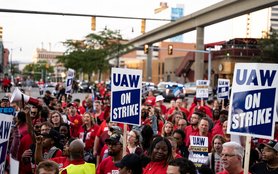The report reveals that COVID-19 ravaged the meat and poultry workforce in even greater numbers than had been estimated. As the industry dragged its feet on taking vital safety measures, tens of thousands contracted the virus; in one plant, half the workers fell ill.
In early 2020, as we began to learn more about how COVID-19 is transmitted, we began to fear for people who had no choice but to leave the home and report to work. Those in poultry and meat processing plants were especially at risk.
We had every reason to believe that these plants provide the perfect environment for transmission of the virus: close proximity on the line, cold and humidity, infrequent access to bathroom breaks. In addition, most workers do not have access to paid sick time or adequate healthcare; and low wages mean they need to report to work every day just to survive, rely on public transportation or shared cars, and often live in crowded situations.
So we kicked into action, working with a broad coalition of workers, organizations, experts, and advocates to demand that the poultry industry take urgent, appropriate steps to protect the lives and well-being of the essential workers standing on the line for our food supply every day. From a letter to the industry in April to a report on the realities inside the plants in August, to engaging companies directly, we issued three specific directives: provide paid leave; implement social distancing; and communicate with workers and the community.
Unfortunately, the industry indicated that it knows better than workers what is needed; and took different steps—ones that were inexpensive, half-hearted, and slow.
The result? Worse than we suspected. While we relied on excellent reporting from the Food & Environment Reporting Network to track outbreaks in the food system, they kept track of public records only. Now it turns out the numbers were even higher.
A newly issued report from the House select subcommittee on the coronavirus crisis says that at least 59,000 workers at the top five companies in the US meat market were infected during the pandemic’s first year. At least 269 workers across these companies died of COVID-19 between March 1, 2020, and Feb. 1.
Even so, the report says outright that the full extent is “likely much worse than these figures suggest.”
While this is shocking, it’s not surprising. When we spoke to workers last summer, they reported on crowded lines, flimsy (if any) masks, lack of information about colleagues who vanished, bonuses for reporting to work even if ill, and a deep and pervasive anxiety.
Listen to the workers themselves
- “When the pandemic began in March, they didn’t care about what was happening. We heard it was spreading all over the country, and they didn’t care. They wouldn’t give us masks. We had to buy our own masks. They would yell at us for wearing them. They did not believe in the disease.” -- Evelyn, a worker with many years on the line at a plant in North Carolina
- “The company doesn’t care about the health of the workers. They’re barely improving conditions after many of us tested positive at work, and some of our co-workers died.” —Ramona, poultry worker in North Carolina
- "Too many people feel sick, but they still come to work until they can’t do the job—then they will go home.” —Khai, poultry worker in North Carolina
Lack of federal mandates left industry to skirt responsibility
Not only did the industry fail to take action, OSHA under the previous administration was notably absent. It refused to issue an Emergency Temporary Standard (ETS) for workers facing exposure to COVID-19, even though the virus was decimating essential workforces. (Under the new administration, the agency did issue an ETS in June 2021, but it applies only to healthcare workers.)
The report notes that this failure from the government to protect workers meant that employers had full discretion in deciding how to proceed. “Without being held to any specific standard, meatpacking companies were left with largely unchecked discretion to determine how to respond to the coronavirus pandemic, to the detriment of meatpacking workers.”
The pandemic has highlighted, once again, that employers will prioritize profits over people no matter the cost to workers and their families—unless they are mandated to implement protections. We need to demand that workers be kept safe and whole; this includes an ETS for COVID-19 that extends to all workers, as well as standards around infectious diseases and climate hazards such as heat.
___________________________________________
Learn more: Read about conditions in poultry plants in 2020, and how workers stood up to demand changes.



